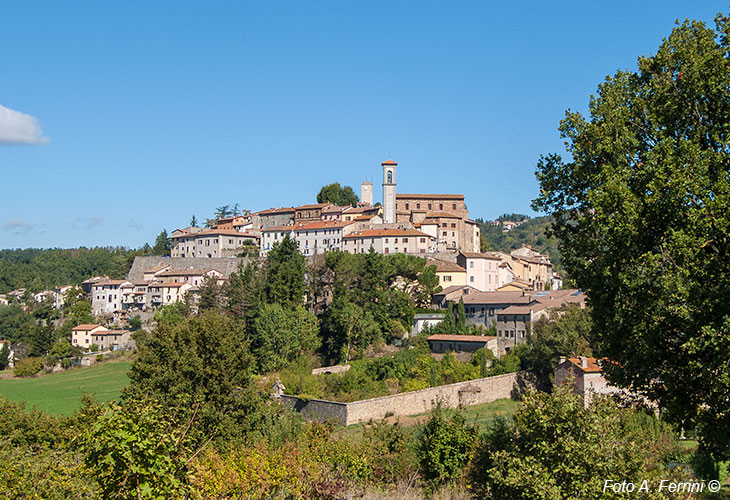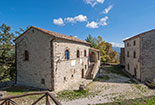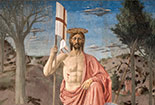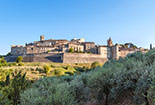MONTERCHI
in Valtiberina, the land of Piero Della Francesca, the first bathed by the Tiber

Texts and photos by Alessandro Ferrini ©
30 accurately described images of Monterchi. Click to enlarge
Monterchi, a castle of the Tarlati on the Mount of Hercules
 Monterchi is located on a small hill from which it dominates the surrounding area mostly consisting of a beautiful agricultural context. It is this hill that gives the town its name, in fact it was called Mons Herculis (Mount of Hercules) since ancient times, hence Monterchi. It is inevitable that in a strategic position like this in medieval times a castle that belonged to the Tarlati di Pietramala did not arise until 1440, the year of the Battle of Anghiari (not far from here) between Florentines and Milanese who decreed the supremacy of Florence in this area. It was not easy for the Tuscan city to maintain dominion over this stronghold also coveted by the Papal State which had its border not far from here. The area is telluric (like the whole Valtiberina) and Monterchi over the centuries has been affected by various earthquakes. In 1917 there was one of particular intensity which destroyed most of the medieval buildings in the town, however architectural evidence of the ancient castle, such as the remains of the walls, are still present.
The older part of Monterchi shows pleasant spots such as a beautiful covered walkway that bears the name of Via De 'Medici. Within the walls there were various churches that were destroyed in the devastating earthquake of 1917. Today one remains, the one dedicated to San Simeone whose origins date back to the early decades of the thirteenth century. Over the centuries it has been the subject of multiple renovations and restorations. The current one is the result of an almost complete rebuilding carried out between 1830 and 1832 and subsequent restorations due to the damage caused by the aforementioned earthquake. The large bell tower next to the facade closed at the top by a tympanum was only completed in 1960. Inside, two works in particular are worth noting: a Presentation of Jesus in the temple by Durante Alberti, a painter from Sansepolcro who worked between the 16th and 17th century, and a detached fresco depicting the Virgin with Child from the nearby church of Santa Maria di Momentana, today the cemetery chapel.
The highest point of the town is represented by La Rocca characterized by a tower with a clock. Next
Monterchi is located on a small hill from which it dominates the surrounding area mostly consisting of a beautiful agricultural context. It is this hill that gives the town its name, in fact it was called Mons Herculis (Mount of Hercules) since ancient times, hence Monterchi. It is inevitable that in a strategic position like this in medieval times a castle that belonged to the Tarlati di Pietramala did not arise until 1440, the year of the Battle of Anghiari (not far from here) between Florentines and Milanese who decreed the supremacy of Florence in this area. It was not easy for the Tuscan city to maintain dominion over this stronghold also coveted by the Papal State which had its border not far from here. The area is telluric (like the whole Valtiberina) and Monterchi over the centuries has been affected by various earthquakes. In 1917 there was one of particular intensity which destroyed most of the medieval buildings in the town, however architectural evidence of the ancient castle, such as the remains of the walls, are still present.
The older part of Monterchi shows pleasant spots such as a beautiful covered walkway that bears the name of Via De 'Medici. Within the walls there were various churches that were destroyed in the devastating earthquake of 1917. Today one remains, the one dedicated to San Simeone whose origins date back to the early decades of the thirteenth century. Over the centuries it has been the subject of multiple renovations and restorations. The current one is the result of an almost complete rebuilding carried out between 1830 and 1832 and subsequent restorations due to the damage caused by the aforementioned earthquake. The large bell tower next to the facade closed at the top by a tympanum was only completed in 1960. Inside, two works in particular are worth noting: a Presentation of Jesus in the temple by Durante Alberti, a painter from Sansepolcro who worked between the 16th and 17th century, and a detached fresco depicting the Virgin with Child from the nearby church of Santa Maria di Momentana, today the cemetery chapel.
The highest point of the town is represented by La Rocca characterized by a tower with a clock. Next  to this there is a terrace that offers a beautiful view of the surrounding green countryside.
In Monterchi there is an exhibition that arouses much curiosity: the Museum of Scales. About one hundred and fifty of these objects, of the most varied types and made over several centuries, are present in this exhibition. The museum is located inside Palazzo Massi, a Renaissance building whose facade is particularly elegant due to the ashlar decoration of the portal and the three windows above.
The notoriety of Monterchi is closely linked to the Madonna del Parto, a fresco painted on an unspecified date (between 1455 and 1465) by Piero Della Francesca for the Church of Santa Maria di Momentana, just outside the town. The Sansepolcro artist created this refined work to honor his mother, Romana di Pierino, a native of this country. Since 1992, the painting has been exhibited in a museum specially created in the premises of a former school just outside the town walls.
Just in front of the Madonna del Parto museum is an ancient religious building. According to tradition, the structure originated before the year 1000 as a hospice for wayfarers and pilgrims. At the beginning of the 11th century it was donated to San Romualdo, founder of Camaldoli, and then passed to the Camaldolese Nuns. The certain history of this building and its church dedicated to St. Benedict (a reference figure for the Camaldolese Order) begins with a mention of him in a document dated 1525. In the mid-seventeenth century the monastery was completely rebuilt. In 1840 the church underwent a major renovation which saw the addition of the canopy over the entrance.
Just beyond the former monastery, a detour to the right leads to the nearby Church of San Michele Arcangelo in Padonchia already mentioned in a document from 1230. Like Monterchi, it was under the patronage of Tarlati until 1440 when it passed under the Florentine Republic. In its architecture there are elements of clear Gothic style. Interesting are the frescoes inside,
to this there is a terrace that offers a beautiful view of the surrounding green countryside.
In Monterchi there is an exhibition that arouses much curiosity: the Museum of Scales. About one hundred and fifty of these objects, of the most varied types and made over several centuries, are present in this exhibition. The museum is located inside Palazzo Massi, a Renaissance building whose facade is particularly elegant due to the ashlar decoration of the portal and the three windows above.
The notoriety of Monterchi is closely linked to the Madonna del Parto, a fresco painted on an unspecified date (between 1455 and 1465) by Piero Della Francesca for the Church of Santa Maria di Momentana, just outside the town. The Sansepolcro artist created this refined work to honor his mother, Romana di Pierino, a native of this country. Since 1992, the painting has been exhibited in a museum specially created in the premises of a former school just outside the town walls.
Just in front of the Madonna del Parto museum is an ancient religious building. According to tradition, the structure originated before the year 1000 as a hospice for wayfarers and pilgrims. At the beginning of the 11th century it was donated to San Romualdo, founder of Camaldoli, and then passed to the Camaldolese Nuns. The certain history of this building and its church dedicated to St. Benedict (a reference figure for the Camaldolese Order) begins with a mention of him in a document dated 1525. In the mid-seventeenth century the monastery was completely rebuilt. In 1840 the church underwent a major renovation which saw the addition of the canopy over the entrance.
Just beyond the former monastery, a detour to the right leads to the nearby Church of San Michele Arcangelo in Padonchia already mentioned in a document from 1230. Like Monterchi, it was under the patronage of Tarlati until 1440 when it passed under the Florentine Republic. In its architecture there are elements of clear Gothic style. Interesting are the frescoes inside, dating from the first half of the fifteenth century to the beginning of the following century. Among the figures represented, a St. Michael, titular of the church, could not be missing, among the oldest frescoes a valuable Madonna and Child.
Not far from the town is the town of Ville di Monterchi. Here we can see the Church of Sant’Apollinare dating back to the 12th century in clear Romanesque style. Very interesting is its still original apse resting directly on the rock. Certainly particular is the large 18th century bell gable built above the apse.
From a historical point of view, it is interesting to note that this church is dedicated to Sant’Apollinare, a reference figure for the Byzantines. The nearby church of Padonchia, described above, is dedicated to San Michele Arcangelo, the saint of the Lombards. A clear sign that in the early medieval era the territory was under the influence of both these civilizations.
It should be remembered that in Ville di Monterchi every year a large and suggestive living nativity scene is staged that occupies an entire hill adjacent to the town.
dating from the first half of the fifteenth century to the beginning of the following century. Among the figures represented, a St. Michael, titular of the church, could not be missing, among the oldest frescoes a valuable Madonna and Child.
Not far from the town is the town of Ville di Monterchi. Here we can see the Church of Sant’Apollinare dating back to the 12th century in clear Romanesque style. Very interesting is its still original apse resting directly on the rock. Certainly particular is the large 18th century bell gable built above the apse.
From a historical point of view, it is interesting to note that this church is dedicated to Sant’Apollinare, a reference figure for the Byzantines. The nearby church of Padonchia, described above, is dedicated to San Michele Arcangelo, the saint of the Lombards. A clear sign that in the early medieval era the territory was under the influence of both these civilizations.
It should be remembered that in Ville di Monterchi every year a large and suggestive living nativity scene is staged that occupies an entire hill adjacent to the town.








































